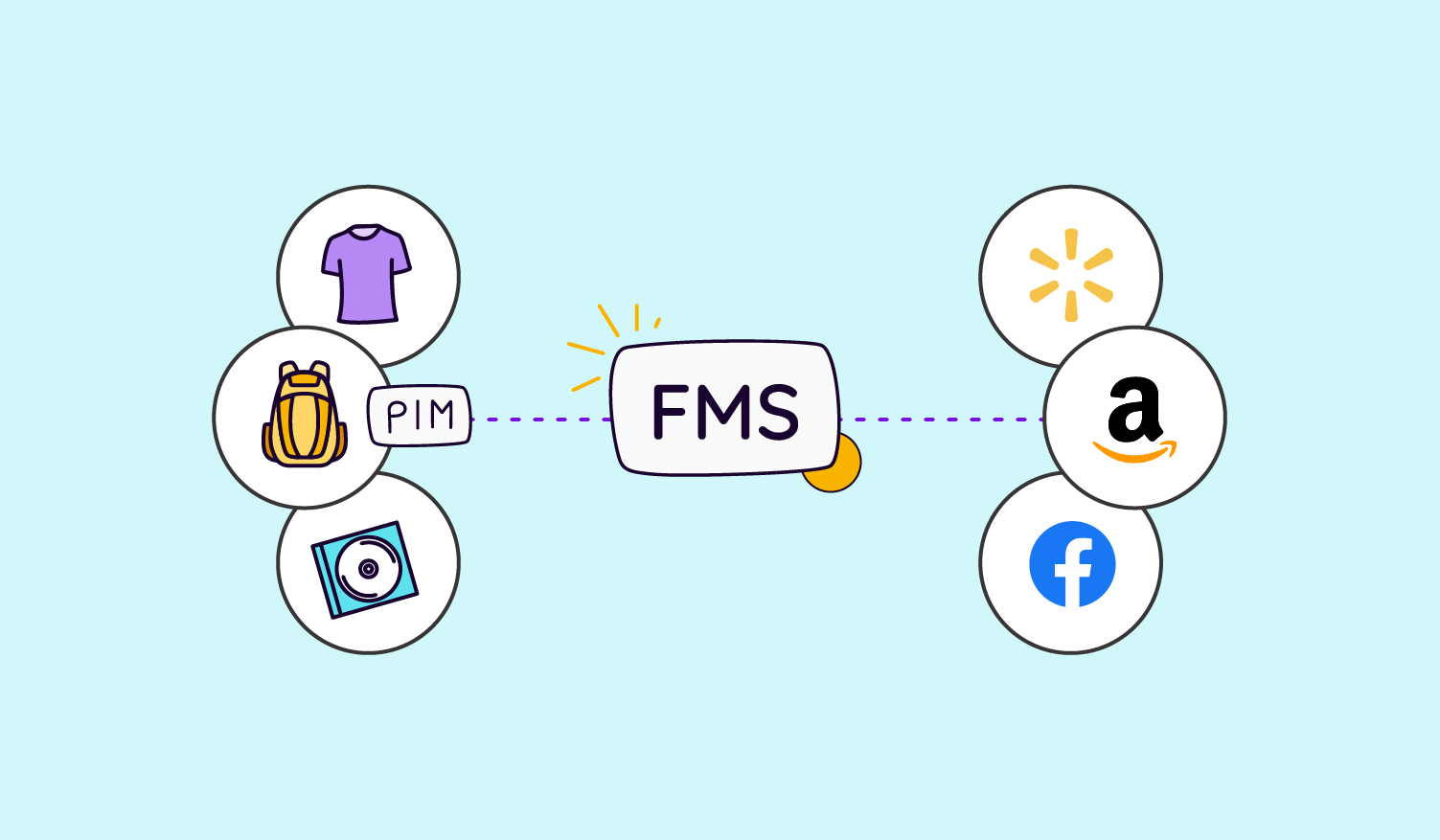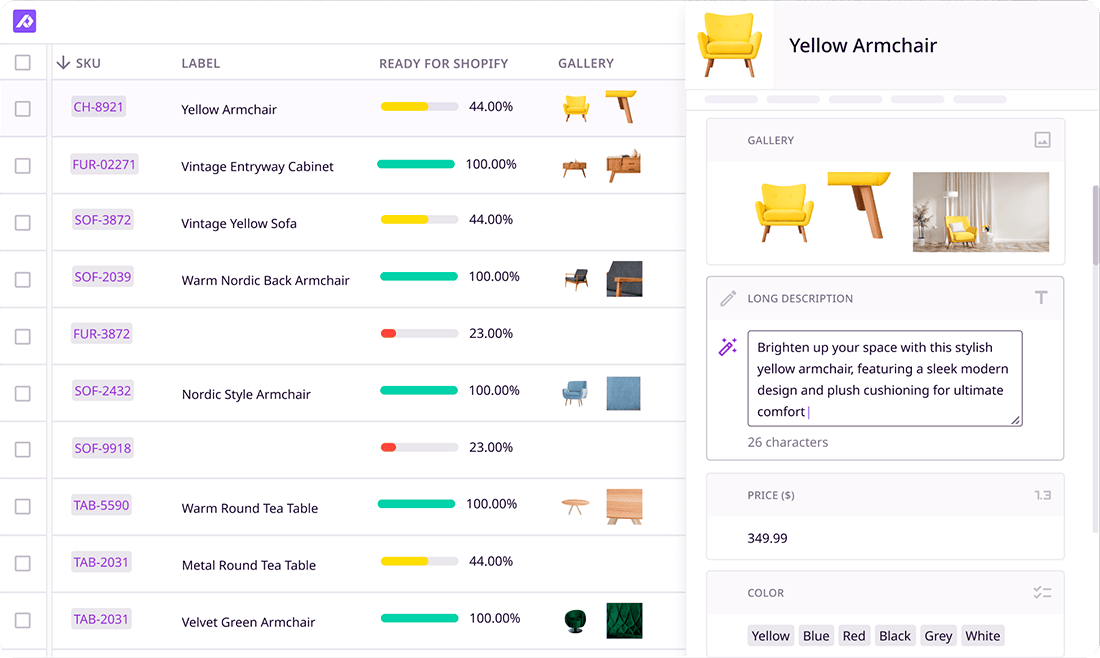
Keep the good stuff coming
Subscribe to our blog newsletter and get monthly content that helps you manage product data smarter.
No spam. Just real value.
Hard truth time: if you want to be successful in online retail, then just selling on one channel or in one place is simply not enough. You need to be everywhere that your customers are, whether that’s third-party marketplaces, price comparison sites, or your own trusty webstore. In fact, this study shows that 72% of consumers prefer to deal with companies that take a multichannel approach, rather than those that only operate on one channel.
That being said, with the multitude of benefits that come with selling on multiple channels come a multitude of hurdles to overcome. One of the biggest issues is the simple question of how to distribute your data to everywhere it needs to go, but without this simple-sounding task taking up too much of your precious time.
Enter stage right, legs akimbo and wearing a cape: technology (my hero!). Modern problems require modern solutions, so naturally, there’s software to help. One of the most popular options for data distribution is software designed for product feed management, and that’s what this article is all about: what this software is, how it connects with other systems, like PIM, and a few of our top provider picks.
What’s a product feed?
To be able to understand what product feed management software is, we first need to understand what a product feed is. At its core, a product feed is a link to a digital list of your products, complete with all their data and metadata, so descriptions, prices, availability, images, and more. These feeds are a way for you to easily or even automatically share detailed, up-to-date product information with everywhere that needs it.
This information is fundamental for your online sales and advertising strategy on all your channels (ecommerce platforms, marketplaces, comparison shopping engines, and so on). The goal? To make sure your products are seen by as many potential customers as possible.
This digital list isn't just a static document—it's dynamic (i.e. constantly updating itself), and can be customized and optimized based on the requirements of your various channels. For example, what Amazon needs to see about your products might differ from what's necessary for Google Shopping or a price comparison wbsite. Getting this right is crucial for visibility, conversion rates, and, ultimately, sales.
What’s product feed management software?
Product feed management software, then, is software used to simplify the complex process of managing and optimizing product feeds. This superpowered software automates the task of creating, managing, and updating product feeds for various online channels, making sure that all your listings are accurate, consistent, and tailored to the specific requirements of each platform.
Product feed management software not only improves efficiency but also helps businesses expand their online presence in a more time-efficient manner. Where it really comes into its own, though, is when it comes to ecommerce operations that deal with a large number of sales channels with varying requirements.
What are the key features of product feed management software?
So, what does this software actually do? Obviously, each tool varies slightly, but some of the key features they have in common are:
- Automation: Naturally, one of the core benefits of product feed management software is its ability to automate the creation, management, and update of product feeds. This automation saves a significant amount of time and resources, eliminating the need for manual updates and keeping your product listings current across all your channels.
- Feed optimization: In addition to that automation, this software also optimizes feeds for each sales channel's specific requirements. Optimization can include adjusting product titles, descriptions, and images to meet the unique standards and best practices of platforms such as Google Shopping, Amazon, eBay, and others, which in turn improves visibility and conversion rates.
Multichannel distribution: Product feed management software lets you distribute your product information to a wide range of channels from a single interface. This feature simplifies the process of reaching multiple marketplaces, comparison shopping engines, advertising platforms, and so on, so you can boost your products’ online presence and potential customer reach.
- Real-time updates: Keeping your product information up-to-date is obviously essential, especially given how quickly things can change in ecommerce. Product feed management software offers real-time updates, so you can relax knowing that your customers will receive accurate information.
- Analytics and reporting: Understanding how your product listings are performing across different channels is vital for strategic decision-making. Product feed management software typically includes analytics and reporting tools that provide insights into feed performance, helping businesses to identify areas for improvement and optimize their product listings for better results.
Customization and flexibility: Every ecommerce business has unique needs based on its product range, target markets, and strategic goals. Product feed management software generally offers customization options to tailor feeds according to these needs, including custom attributes and category mapping, to make feeds meet the specific requirements of each sales channel.
- Inventory and order management: Keeping track of orders and stock levels across your sales channels can get complicated, and it only gets more complicated as you start to sell in more and more places. Product feed management software can help you quickly share order and inventory information more easily between your webshop, other sales channels, and the other systems you use behind the scenes (like ERP and PIM).
What are some popular providers of product feed management software?
There are a number of providers and players that dominate the product feed management software market, and each one offers unique features and capabilities. We’re going to let our favorite picks introduce themselves in their own words, courtesy of G2.
Channable empowers brands, retailers, and agencies to better reach consumers and increase online sales by managing and optimizing your product data – in one platform.
ChannelEngine is an ecommerce integration platform. It enables businesses to connect their webshop and back-end systems (ERP, PIM, WMS) to a central platform that integrates with 700+ marketplaces and sales channels.
ChannelPilot is a cloud-based, innovative multichannel solution for online shops, agencies and brands. Products are automatically placed on thousands of online platforms globally.
Shoppingfeed is a single platform to list, sync, and manage your products and orders with the world's largest marketplaces and shopping engines. It offers everything you need to quickly grow sales volumes through a multi-channel e-commerce strategy.
Each of these providers offers different strengths, so choosing the right one depends on your business needs, the complexity of your product catalog, and the channels you're targeting. Like with all software, the best thing you can do is investigate the different options available on reputable review sites (like G2), and then book some demo calls with your shortlist to see which is the best fit.
What’s the difference between Product FMS and PIM software?
If you’ve been looking into software to help manage your product information, there’s a good chance you’ve also come across software called Product Information Management, or PIM. Although they might seem similar at first glance, product feed management software and PIM software serve distinct functions within the ecommerce ecosystem.
Product Feed Management software
This software is all about making sure your product listings are out there and reaching potential customers wherever they are online. It focuses on optimizing and distributing product data feeds to various sales and marketing channels, and helps push order and inventory-related data between your systems too.
PIM software
PIM, on the other hand, is more like the internal library of your product information. It's where you collect, manage, and enrich your product data, guaranteeing accuracy and consistency across all platforms. Think of PIM as the foundation that supports your overall product information strategy, including (but not limited to) feed management.
In short, while product feed management software is great for sharing your data between multiple platforms and systems, PIM software is where all that product information lives, breathes, and gets polished before it goes out into the world.

How can PIM and feed management software work together?
While PIM software generally has some product feed management functionality, the reverse tends not to be the case. As such, depending on your company’s situation and needs, you may well find that your best option is to use both—here’s how they work together:
- Accuracy, consistency, and distribution: PIM acts as the single source of truth for your product data, which makes it way easier to maintain that all-important accuracy and consistency. Product feed management software then takes this data and helps you distribute it to your various channels, in the best way possible for each one. This tag team optimization of your feeds helps increase your visibility and, ultimately, your sales.
- Efficiency and scale: By centralizing product information management using PIM software, businesses can quickly update product details whenever necessary. Those updates can then be automatically reflected across all sales channels using the product feed management system. This seamless connection is what lets businesses scale up online sales operations super rapidly—but without sacrificing data quality.
- Customization and reach: The combination allows for advanced customization of your data, so you can create product feeds based on channel-specific requirements and maximize your reach and engagement on each platform. Use this tech right and it’ll mean your products are not just seen but seen well, as they’ll also be presented in the best possible way to attract potential buyers.
Of course, implementing two different software solutions is going to mean more of an investment of time, money, and effort at the start, but it can absolutely be worth it in the long run. Combining both systems makes your operations more streamlined and efficient, increases your online presence, and boosts sales by making sure that your products are accurately represented and widely available, everywhere that they need to be.
Final tips and resources
Ultimately, nothing manages product information better than product information management software, and nothing manages product feeds like product feed management software—there’s a clue in the names. Logically then, each option has its own strengths and can be effective on its own, but combining the two is what’s going to get the best results and give your business the superpowers it needs. Using these two types of software together can significantly improve your ability to manage product information efficiently, scale your online presence, and increase sales across multiple channels.
To dive deeper into how you can harness the awesome power of these technologies to supercharge your ecommerce strategy, you can download our comprehensive ebook on combining PIM and feed management software. We’ve packed it full of insights, tips, and actionable strategies to help you navigate the digital retail landscape more effectively. Don't miss out on this valuable resource—download your copy today and take the first step toward a more efficient, more profitable online business.
Frequently Asked Questions
A product feed is a digital list containing details and metadata about your products, such as descriptions, prices, availability, and images. It's designed to share updated product information easily across different online platforms to improve your sales and advertising efforts. This list is dynamic, constantly refreshing itself, and can be tailored to meet the distinct requirements of various online channels, making sure that your products are displayed accurately and effectively to maximize visibility and sales.
Feed management software is a tool used to streamline the management and optimization of product feeds across multiple online channels. It automates the processes of creating, updating, and customizing product feeds, making sure that they meet the specific requirements of each sales platform. This software aids in maintaining accurate and consistent product listings, saving time and resources, and boosting online presence and sales potential across diverse ecommerce platforms.
PIM (Product Information Management) software acts as a centralized repository for managing and enriching your product data, guaranteeing its accuracy and consistency across all sales channels. It's the backbone of your product information strategy, supporting the improvement and organization of product data before it's distributed. PIM is crucial for maintaining a solid foundation of product information, which supports effective feed management and overall ecommerce success.
PIM and feed management software complement each other by making sure that product information is accurately maintained and effectively distributed across multiple channels. PIM software serves as the central source of truth for product data, providing a consistent and accurate foundation. Feed management software then leverages this data to optimize and distribute product feeds to various online platforms. Together, they allow for efficient updates, customization for channel-specific requirements, and scalability in online sales operations, boosting visibility, engagement, and sales.

What if your product data actually worked for you?
We’ll show you how Plytix helps you stop fixing data—and start using it.
Related posts
Keep the good stuff coming
Subscribe to our blog newsletter and get monthly content that helps you manage product data smarter.
No spam. Just real value.











Think others should see this?
Go ahead and share it.